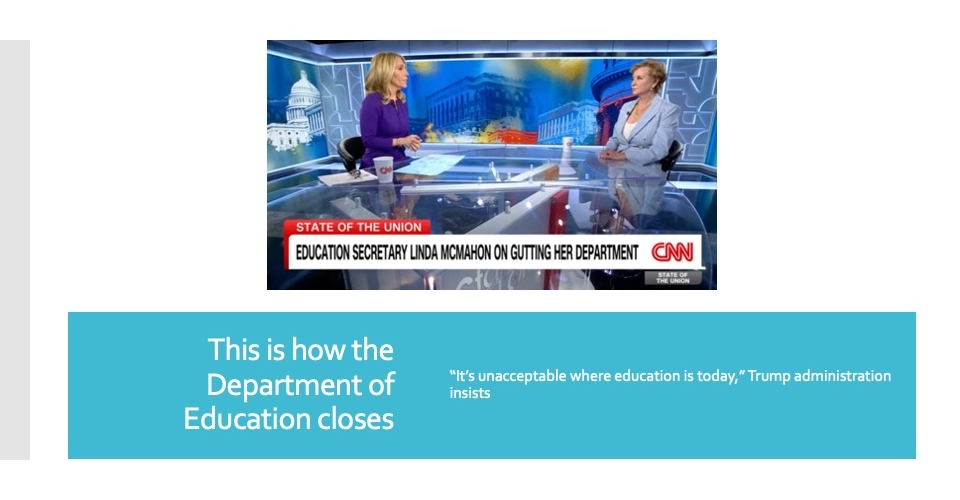“Districts now have more staff than ever and fewer students. So what happens next? That’s an unusual place for us to be. We’re new to it. That means there are changes afoot.”
As more time passes, what experts predicted surrounding the four financial shocks on public education is getting closer to becoming a reality, explained Marguerite Roza, director of Georgetown University’s Edunomics Lab during a webinar on Thursday. But before districts reach that fourth and final financial shock, they’ll have to brace a steep decline in financial resources, a.k.a. “the bloodletting,” as she calls it.
According to Roza, these are the districts most at risk when ESSER spending ends abruptly in September of 2024:
- ESSER is boosting spending, but that ends abruptly in September 2024.
- Most at risk: Districts using ESSER for recurring financial commitments via budget backfilling, new hires, or permanent raises.
- Enrollment declines mean fewer revenues in the long run.
- Most at risk: Urban districts, districts closed longer, and northern states.
- Inflation, labor scarcity, and new hiring are driving up recurring commitments.
- Most at risk: Those offering permanent raises that are larger than typical and those growing their staff roles.
- An economic slowdown would affect growth in state revenues.
- Most at risk: Districts that are more dependent on state revenue (or in states more affected by economic slowdowns).
But this likely isn’t new to you. Superintendents have been bracing for this event for some time. However, Roza explained that as districts are finalizing their 2023-24 budgets, they’re getting a clearer picture of public education’s financial outlook. And one of the most concerning trends they’ve identified is the disproportionate balance between school staffing and student enrollment.
“Enrollment has fallen and it’s not rebounding,” said Roza. “So maybe there’s a little bit of a rebound of a rebound, not everywhere, but enrollment really looks to be going the opposite direction of staffing.”
Many districts are already predicting deficits in their budgets in the next few years, she added.
“That’s what spells trouble,” she said. “It could be very disruptive in the coming months.”
More from DA: Superintendents should know the 4 reasons students give school a B-
How severe is the gap between staffing and enrollment?
Unfortunately, there isn’t any national school staffing data for economists like Roza to pull from to give us the most accurate forecast, she explained. Instead, her team at the Edunomics Lab had to take an “apples-to-apples” approach to conduct staffing counts by analyzing data from several states and hundreds of districts.
For instance, in Connecticut, staffing levels went up roughly 8% over the last decade while enrollment fell 7%. Michigan is experiencing a similar trend as staffing levels rose 9% while student enrollment fell by 8%.
“Our systems are becoming more staff heavy, even as they have fewer students,” said Roza.
In Massachusetts, districts have added more than 17,000 staff, roughly a 14% increase while losing 4% or 42,000 students.
“Never have we seen such rapid expansion of labor in education,” she said. “And obviously that’s been fueled by ESSER, but that’s a real sizeable growth in the labor force in a short amount of time in places like Massachusetts.”
Even in states where enrollment is growing, like Texas and Washington, staffing rates are growing much faster. She also pointed out that while other job industries are reducing their labor forces due to transformation and disruption caused by technology, the education sector is only becoming more reliant on labor.
What comes next?
To recap, districts are experiencing these enrollment and staffing trends in response to two primary waves of funding sources:
- In 2015-2019, strong state revenues fueled hiring before enrollment started declining.
- ESSER funds boosted an already-growing hiring trend while enrollment continued to decline.
Looking ahead, Roza said districts should prepare for a significant reduction in jobs after September of 2024 since districts will no longer be able to leverage ESSER funds for labor. At the moment, roughly $24 billion of ESSER III is being allocated toward labor costs in school districts. According to Roza, this equates to roughly 250,000 education jobs.
“But we’re not expecting quite this many job cuts, certainly not immediately because districts can tap their reserves and shrink some of their vendor contracts and things like that to hold onto staff and potentially go with flatter raises going forward,” she said. “But all told, 4% of the education jobs out there hang in the ESSER balance right now.”
The next question, Roza asked, is will state revenues make up the difference. The answer: it’s not likely. Most states aren’t experiencing the necessary growth in revenue to sustain promised pay raises and other financial decisions districts made during and after the pandemic.
In conclusion, Roza said district leaders and educators alike can anticipate staff reductions in five ways:
- Attrition (hiring freezes)
- Layoffs
- Incentives for early retirement
- Reduced days/furloughs
- Lower pay raises



